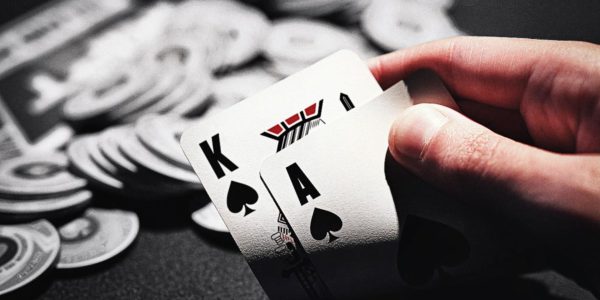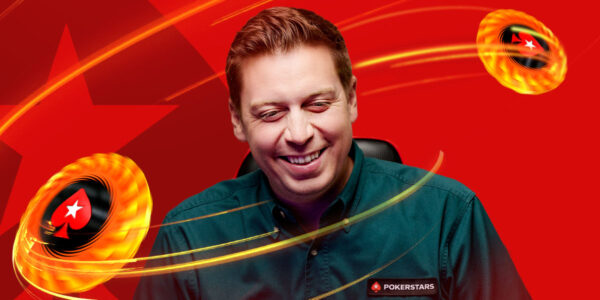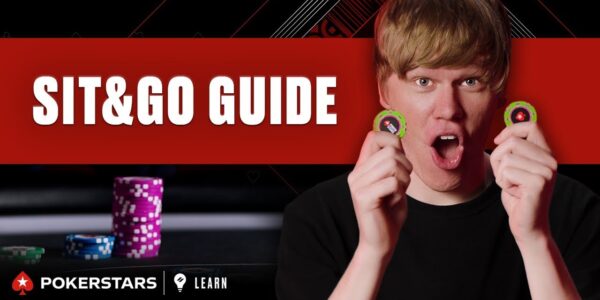Heads Up Strategy as the SB
You might think that the beginning of the tournament might be the best place to start our journey into Grand Tour strategy, but the first spot, chronologically speaking, is nowhere near as important as the most common spot, the heads up.
You will spend a great deal of your time in Grand Tour battling heads-up. All four players rarely hang around long in a hyper turbo format with bounties incentivising action left, right, and centre. The heads-up battle, however, can go on for some time. For this reason, our journey begins at the end.

Don’t miss the special Grand Tour streams every Thursday at 10am GMT on the PokerStars Twitch channel
A lot of the strategies examined below are push or fold ones – meaning that we either go all-in or fold as the SB (also known as the BU when Heads-Up). It does not matter greatly by the time you are heads-up who is at risk of busting. All that matters is the stack depth of the lowest stacked player – we call this the effective stack.
10-15BB – Whether to Build a Limping Range
Although it is a viable approach, you might not want to resort to a push or fold game every time the effective stack gets this short. Building a limping range is also an option. This is tough to do in a balanced way, and, against a good opponent, it is unlikely to be worth it. That said, there are a couple of player types against whom we do want a limping range even as stacks approach the 10 big blind mark.
- We want to limp a weak range vs. people who check too often in the big blind. This lets us realise a lot of equity and our bad hands perform better by limping than by folding.
- We want to limp a strong (trap) range vs. people who shove too often.
12BB Push or Fold Range
Assuming that you are going to play a push or fold game at 12BB in the SB, here’s how you should do it:

Now, time for an important observation about shoving pre-flop. The hands at the bottom of this range like K3o and 74s are only slightly better than break even to jam with. You will want to avoid jamming them when:
- Your opponent is passive and letting you see a lot of flops by limping and where you have a skill edge post-flop.
- Your opponent is a shoving manic and will present you with much better chances to get your money in. In this case you can simply fold K3o and wait for a better spot. In this case it might be +chip EV to shove, but higher $EV to wait for a different spot. Our focus must be on making money, not chips.
10BB Push or Fold Game
When we drop down to 10BB stack depth, some more hands become profitale shoves as we are now risking less money to take down the pot. With only 10BBs in play, we need a stronger reason to develop a limping range than we would at 12BB stack-depth. Limp/folding a hand with some reasonable equity is a big mistake against anyone who is doing a lot of shoving in the BB.

8BB Push or Fold Game
Time runs out fast in Grand Tour. If you find yourself with only 8BBs effective, it is time to get aggressive. One big mistake you see weaker players make at this stack depth is being too selective about what they jam. If your opponent let’s you blind him away, he guarantees his demise, while, by taking a stand with a weak hand, there two avenues to prosperity – fold equity and winning a 40:60 all-in. When you hold 87s, for example, this combined chance of improving your chip position is a lot better than dropping down to 7BB and posting another big blind.
There is no point being alive if you are too short to generate folds or double up to a strong position.
If your opponent in the big blind is folding too often to shoves, then by all means expand this shoving range. We need to crank the pressure right up against overly tight players as this stack depth.

6BB Push or Fold Range
Q2o you say? Well, think about it. How do you feel about having a 5BB stack next hand and being the one facing the all-in? Much worse, right? At 6BB it is do or die time. In my limited foray into Grand Tour thus far, I have already seen some unbelievably tight play at this stack depth. It is possible to gain a huge edge over an opponent who does not understand the urgency of getting it in when only 6BB deep.

4BB Push or Fold Range
And finally, we reach the shortest possible stack size where the SB is not simply committed to the hand pre-flop. At stack depth of 2BB or 3BB, folding is no longer a viable option (though you do see people make this error.) With only 4 big blinds in play, we cannot be fussy at all. If it has a jack in it, well….game on! If it is, suited, and better than a nine and a two, let’s do this!

Conclusion
Once again, these ranges are merely a guide. If you can keep maximum focus at the beginning of the tournament, you put yourself in a position to capitalise on your opponents’ leaks when the time comes to play push/fold.
Next time, we discuss the intricacies of reacting to the shove and step into the less pleasant world of being the big blind.
Test your knowledge with our short quiz below














